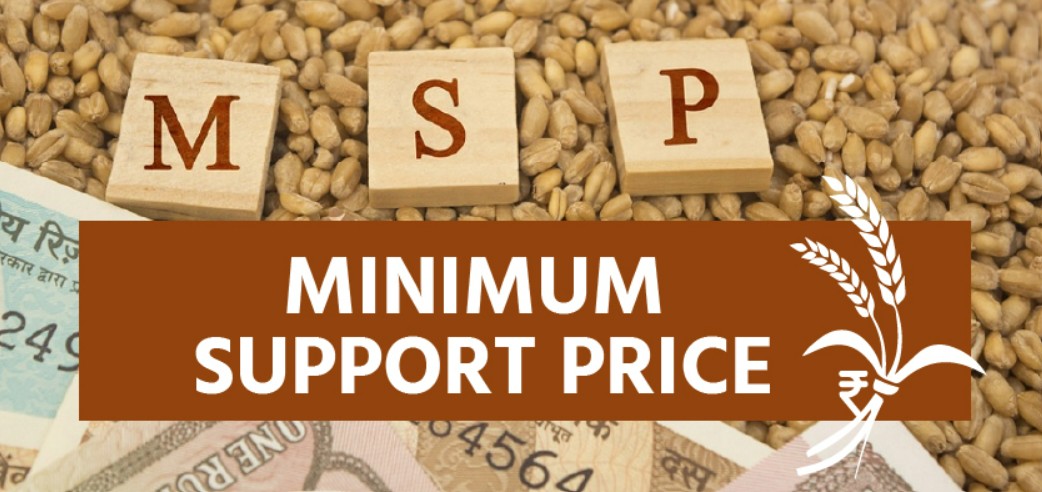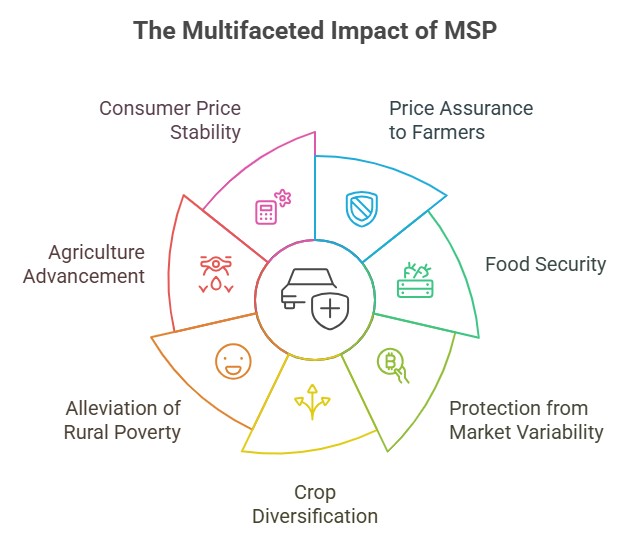Minimum Support Price (MSP) is the government-fixed price to safeguard farmers against market fluctuations. Learn about objectives, significance, issues, reforms, and recent developments in MSP for agricultural crops.

Minimum Support Price is minimum price set by government at which commodities are procured from farmers by government.

Refer diagram ???? ????


The Government of India announces the Minimum Support Price (MSP) for 22 major crops every year to safeguard farmers against any sharp fall in farm prices. This system ensures that farmers receive a fair return on their produce, promoting agricultural stability and income security. In addition to these 22 crops, Toria and de-husked coconut are also covered under MSP, determined on the basis of rapeseed & mustard and copra prices respectively.
The crops covered under MSP are categorized into Kharif crops, Rabi crops, and commercial crops as given below.
Kharif crops are typically sown with the onset of the monsoon and harvested in autumn. The following 14 Kharif crops are covered under MSP:
Rabi crops are sown in the winter season and harvested in the spring. The government provides MSP for the following 6 Rabi crops:
Commercial crops are cultivated primarily for sale rather than personal consumption. The government announces MSP for the following 2 commercial crops:
Legalisation of MSP means legal obligations on the government to buy commodities for which MSP is announced. After repealing three contentious farm laws farmers had put the demand of legalising MSP.
Rather than legalisation of MSP focus should be on infrastructure development and strengthening institutions and guarantee farmers to increase their income.MSP provided safety net to the farmers via market against uncertainties but there is a need to make advancement in the process according to the need.
Recent developments/initiatives:


Refine your answer writing skills and elevate your UPSC preparation with personalized support and expert feedback.
Fill out the form to get started with the program or any other enquiries !








Are you dreaming of becoming an IAS officer? Then, IAShub can be your best guide. It is one of the Best IAS Coaching in Delhi. Many students who want to clear the UPSC exam join IAShub for learning. The institute gives both online and offline classes. Their teachers are experienced and helpful. They easily explain every topic. Students also get notes, tests, and tips to do well in the exam.
IAShub is in Delhi and is trusted by many UPSC students. It offers coaching for every part of the UPSC exam – Prelims, Mains, and Interview. The classes are simple and easy to understand. The teachers are experts and guide students in the right way. IAShub is also known for its helpful notes, test series, and answer-writing practice. IAShub is the best coaching in Delhi and also gives UPSC Online Classes. This helps students from any place in India to learn. The online classes are live and also recorded. So, students can watch them anytime. These classes cover the full UPSC syllabus.
Here are some important services provided by IAShub:
The UPSC Civil Services Exam has three parts:
This exam is tough, but with the right guidance, it becomes easy to manage. Students must study smart and stay regular.
IAShub supports students from the beginning to the end. It gives the right books, tests, and notes. The classes are easy to follow, and the teachers are always ready to help. Students get personal doubt sessions too. The test series and answer checking help students learn where they need to do better. Also, free study materials save time and money.
IAShub also guides students during the final stage – the interview. Experts take mock interviews and give useful tips. This full support makes IAShub one of the best IAS coaching in Delhi.